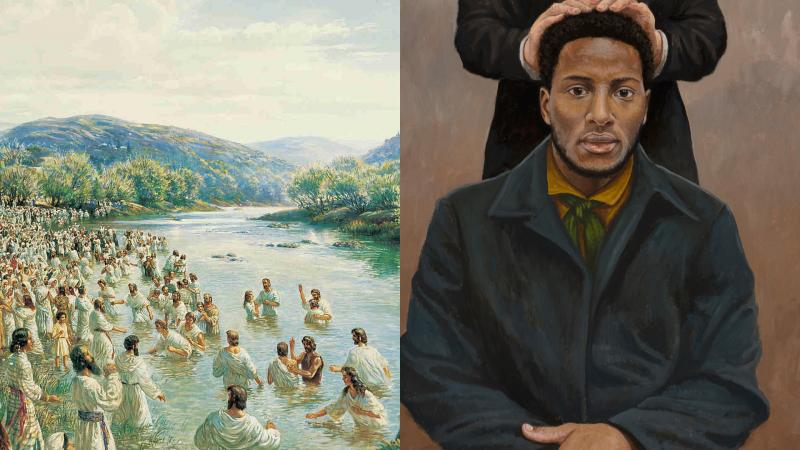You are here
Book of Mormon Central is in the process of migrating to our new Scripture Central website.
We ask for your patience during this transition. Over the coming weeks, all pages of bookofmormoncentral.org will be redirected to their corresponding page on scripturecentral.org, resulting in minimal disruption.
This week, as part of our Come, Follow Me study, we revisit the miraculous events which occurred on the day of Pentecost (Acts 2), ten days after the Lord’s ascension. As the apostles were “all with one accord in one place” a “rushing mighty wind … filled all the house where they were sitting” and they saw “cloven tongues like as of fire” resting upon all those in attendance (vv. 1–3). Filled and emboldened by the Spirit, they began preaching to the large crowd of people from “every nation under heaven” and, miraculously, “every man heard them speak in his own language” (vv. 5–6). Peter, as the chief apostle, got up and explained that they were witnessing the fulfillment of the prophecy recorded in Joel 2:28–32 and then bore witness of Jesus, that he had risen from the dead and was both Lord and Christ, the promised Messiah (Acts 2:16–36). The multitude was “pricked in their heart” and three thousand were baptized that day (Acts 2:37–41).
Pentecost is the Greek name for the Jewish Feast of Shavuot (“Weeks”), celebrated 50 days after Passover (Deuteronomy 16:9–12), which means it usually occurs in late May or early June. It commemorated the occasion in which Moses received the law on Mount Sinai. It was also around this time that God appeared to Moses and seventy elders on Mount Sinai (Exodus 24:9–10). Moreover, the experiences of the New Testament apostles in Acts 2 have given Pentecost its own meaning within Christian tradition, with great outpourings of the Holy Spirit, revelation, or miracles often being described as pentecostal-like experiences. And thus Latter-day Saints often refer to the outpouring of visions and spiritual experiences during the Kirtland temple’s dedication in 1836 a day of Pentecost,1 as angels and lights appeared, and priesthood keys were restored (see Doctrine and Covenants 110).
And just as important, another Pentecost-like occasion occurred in Church history 45 years ago, in June 1978, when the priesthood and temple blessings were extended to all who were worthy, regardless of race or lineage. President Spencer W. Kimball, and several other Church leaders before him, had wrestled with questions pertaining to the priesthood restriction for years leading up to 1978. Since its implementation under Brigham Young, prophets had promised that one day the restriction would be lifted, although the timing of when that would occur was not known or well understood. In the months and weeks leading up to the revelation, President Kimball spent more and more time at temple in prayer and deep thought, seeking to know the Lord’s will. He also frequently counseled with his fellow apostles in the First Presidency and Quorum of the Twelve on the matter.
By late May, it had become clear to him that it was the Lord’s will for this waiting period to end. He proposed a tentative statement along these lines to his counselors in the First Presidency on May 30. Then, on Thursday, June 1, 1978, the First Presidency and the Quorum of the Twelve Apostles came together in fasting and prayer in the Salt Lake Temple. President Kimball informed his Brethren that he believed it was the Lord’s will that men of African descent no longer be restricted from holding the priesthood or (along with women of African descent) from participating in related temple ordinances. In that Thursday meeting, a miraculous outpouring of the Spirit occurred among these leading Brethren confirming that this was indeed the mind and will of the Lord. Elder Bruce R. McConkie, who was present as one of the Quorum of the Twelve, said, “The Spirit of the Lord rested upon us all; we felt something akin to what happened on the day of Pentecost and at the Kirtland Temple.”2
He further explained:
On the day of Pentecost in the Old World it is recorded that cloven tongues of fire rested upon the people. They were trying to put into words what is impossible to express directly. There are no words to describe the sensation, but simultaneously the Twelve and the three members of the First Presidency had the Holy Ghost descend upon them and they knew that God had manifested his will.3
Elder L. Tom Perry, another of the Twelve present on the occasion, said, “We had just a unity of feeling. The nearest I can describe it is that it was much like what has been recounted as happening at the dedication of the Kirtland Temple [and the day of Pentecost]. I felt something like the rushing of wind. There was a feeling that came over the whole group.”4 Spencer W. Kimball himself described it as “a rushing flood of unity such as we had never had before.”5
The spiritual outpouring did not end there. Over the next several days, the First Presidency and Quorum of the Twelve busied themselves with preparations for announcing this revelation to the world. On June 8, the precise wording of the announcement had been agreed upon by all the apostles (Official Declaration 2). Then they gathered the Quorums of the Seventy and other General Authorities together and announced it to them on Friday, June 9, 1978. A strong outpouring of the Spirit occurred on this occasion as well, and one of the attending brethren said, “I would have voted against such a proposal until I experienced the feeling that I did in this room this morning.”6 As the announcement then went out to the world later that day, many others had similarly powerful experiences as they learned of the Lord’s revelation to his prophet.7 According to Edward L. Kimball, son of President Kimball:
The news brought nearly universal rejoicing among members, both because of the extension of blessings to worthy families who had been denied them, but also because it illustrated in dramatic fashion the Church teaching that revelation continues to the present. As the news spread through Utah and beyond, people embraced and cried and rejoiced.8
Remarkably, the timing of this pentecostal-like spiritual outpouring beginning with President Kimball himself in late May and extending to his counselors, the Twelve, the Seventy, and then the world, coincided with the time of year typically associated with Feast of Weeks or Pentecost. In 1978 specifically, Shavuot began the night of June 9, 1978—the same day on which the revelation was announced to the world.
As with Moses and the Seventy on Mount Sinai, and as with Peter and the Twelve at the Jerusalem temple,9 in 1978 the Lord’s prophet had received a powerful revelation in the Lord’s temple, and it was ratified in that temple by the Twelve and also the Seventy. Thus, heavenly blessings and opportunities once restricted were now openly extended to all worthy men throughout the world, just as “devout men, out of every nation under heaven” (Acts 2:5) had heard and received the blessings of the gospel on the day of Pentecost in the New Testament.
- 1. Scott R. Petersen, Where Have all the Prophets Gone? Revelation and Rebellion in the Old Testament and Christian World (Springville, UT: Cedar Fort, 2005), 329–331.
- 2. Bruce R. McConkie, “The New Revelation on Priesthood,” in Priesthood (Salt Lake City: Deseret Book, 1981), 127–128.
- 3. McConkie, “Receipt of Revelation,” as cited in Edward L. Kimball, “Spencer W. Kimball and the Revelation on Priesthood,” BYU Studies 47, no. 2 (2008): 56.
- 4. L. Tom Perry, interviewed by Edward L. Kimball, June 15, 1978, quoted in Kimball, “Revelation on Priesthood,” 56–57.
- 5. As quoted in Kimball, “Revelation on Priesthood,” 59.
- 6. As quoted in Kimball, “Revelation on Priesthood,” 65.
- 7. See the stories related in Kimball, “Revelation on Priesthood,” 69–76 for examples.
- 8. Kimball, “Revelation on Priesthood,” 72.
- 9. John T. Squires, “Acts,” in Eerdmans Commentary on the Bible, ed. James D. G. Dunn and John W. Rogerson (Grand Rapids, MI: Eerdmans, 2003), 1218 suggests that Luke “leads us to expect the location of the Pentecost story to be in the temple.”
Subscribe
Get the latest updates on Book of Mormon topics and research for free



